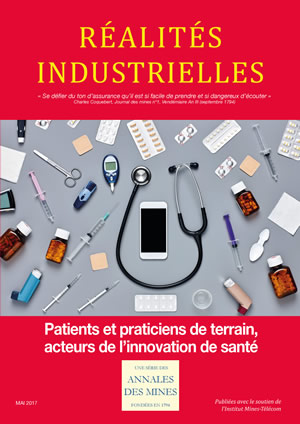|
 Mai 2017 - Patients et praticiens de terrain, acteurs de l’innovation de santé Mai 2017 - Patients et praticiens de terrain, acteurs de l’innovation de santé
Le rôle des patients et de leurs associations représentatives dans l’innovation en santé : représentations et transformations réelles
Par Caroline GUILLOT
Responsable du Diabète LAB à la Fédération française des diabétiques
On note aujourd’hui une évolution importante de la représentation des patients dans le monde médical, ceux-ci passant du statut de patients-alibis à celui de patients-acteurs. Un discours structure cette représentation dominante, la verbalise. Mais comment cette nouvelle représentation peut-elle entrer dans les faits, dans l’organisation concrète du monde médical ?
Deux forces majeures sont capables d’opérer cette transformation. D’une part, le patient est beaucoup plus sollicité (pour des raisons techniques) et la monopolisation du savoir par le médecin s’en trouve ébranlée.
D’autre part, s’appuyant sur cette tendance, les associations de patients passent d’une vision défensive à une vision proactive. En développant leur capacité d’analyse des données sur les patients, en interrogeant leur expérience vécue, en cherchant à coévaluer et à coconcevoir de nouvelles solutions en santé, elles donnent force aux patients-acteurs.
Il est primordial de suivre attentivement ces transformations, car elles semblent irréversibles et aboutiront à une profonde modification du monde médical.
 Télécharger gratuitement l'article Télécharger gratuitement l'article
 Retour au sommaire Retour au sommaire
 May 2017 - Patients and practitioners in the field: Innovations in health May 2017 - Patients and practitioners in the field: Innovations in health
The role of patients and their organizations in health innovations: Conceptions and real transformations
Caroline Guillot,
head of Diabète LAB at the French Federation of Diabetics
Ideas about patients are undergoing a major change in the realm of medicine: a shift from the “patient alibi” to the “patient-actor”. A discourse has shaped this dominant view of patients and put it into words. But how to make this new conception enter the realm of acts and the concrete organization of medicine? Two principal forces are capable of making this change. On the one hand, patients are much more often solicited (for technical reasons), and the doctor’s monopoly over knowledge is being questioned. On the other hand, patient organizations are using this trend to switch from a defensive to a proactive attitude. By analyzing patients’ data, inquiring into their experiences, and trying to co-assess and co-design new solutions for health, these organizations place the patient as an actor in the process of care. It is of utmost importance to closely follow these apparently irreversible trends, since they will transform the realm of medicine.
 Retour au sommaire Retour au sommaire
 Mayo 2017 - Pacientes y profesionales sobre el terreno, agentes innovadores de la sanidad Mayo 2017 - Pacientes y profesionales sobre el terreno, agentes innovadores de la sanidad
El papel de los pacientes y sus asociaciones representativas en las innovaciones sanitarias. Representaciones y transformaciones reales
Caroline Guillot,
Responsable del Diabète LAB de la Federación francesa de diabéticos
Actualmente se observa un cambio importante en la representación de los pacientes en el mundo médico, éstos ya no se consideran como pacientes-excusa sino como pacientes-actores. La teoría estructura esta representación dominante y la verbaliza. Pero, ¿cómo hacer que esta nueva representación entre en la realidad, en la organización concreta del mundo médico?
Dos fuerzas mayores pueden efectuar esta transformación. Por una parte, el paciente contribuye mucho más (por razones técnicas) y el monopolio del conocimiento por parte del médico se pone en tela de juicio.
Por otra parte, apoyándose en esta tendencia, las asociaciones de pacientes han pasado de una visión defensiva a una visión proactiva. Al desarrollar su capacidad de análisis de datos sobre los pacientes, aprovechando su propia experiencia, tratando de co-evaluar y co-diseñar nuevas soluciones sanitarias, las asociaciones dan el poder a los pacientes miembros.
Es fundamental seguir de cerca estas transformaciones, ya que parecen irreversibles y sin duda provocarán una profunda transformación en el mundo médico.
 Retour au sommaire Retour au sommaire
|




